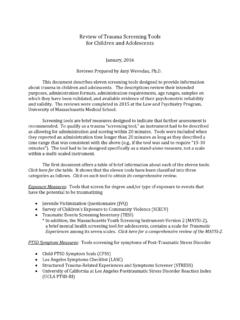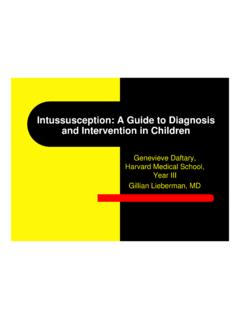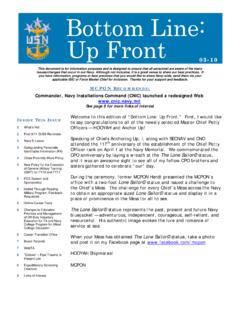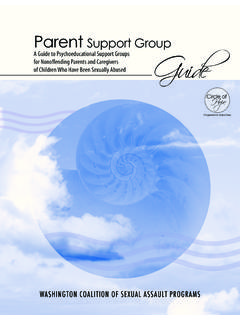Transcription of CASE MANAGEMENT TOOLKIT - ISS USA
1 case MANAGEMENT TOOLKIT : A USER'S GUIDE FOR STRENGTHENING. case MANAGEMENT SERVICES IN CHILD. WELFARE. JULY 2014. This report was produced for review by the United States Agency for International Development. It was prepared by the Center for International Social Work at Rutgers University's School of Social Work and International Social Service-USA for JBS International under Contract No. AID-OAA-BC-10-00005. Page 1. case MANAGEMENT TOOLKIT : A USER'S GUIDE FOR STRENGTHENING. case MANAGEMENT SERVICES IN CHILD. WELFARE. DISCLAIMER. The authors' views expressed in this publication do not reflect the views of the United States Agency for International Development or the United States Government case MANAGEMENT TOOLKIT TABLE OF CONTENTS. Acronym List .. iv Glossary of Terms .. vi Executive Summary .. ix Introduction .. 1. Why this TOOLKIT .. 1. Purpose of the 2. Methodology .. 3. How the TOOLKIT is Organized .. 3. Section 1: Core Components of Child Welfare case MANAGEMENT .. 4.
2 System (Macro) Level case 4. Individual (Micro) Level case MANAGEMENT .. 8. Section 2: Measuring Child Welfare case MANAGEMENT .. 14. Section 3: Status of Child Welfare case MANAGEMENT in the E&E Region .. 25. System-Level Components .. 25. case -Level Components .. 28. Section 4: Good Practices from the Field .. 30. Armenia .. 30. Azerbaijan .. 32. Georgia .. 34. Moldova .. 35. Russia .. 38. Ukraine .. 40. Romania .. 42. Findings and Recommendations .. 46. References .. 50. Appendix A: case MANAGEMENT Assessment Tool .. 63. Appendix B: Additional Country and Region-Specific Resources and Tools .. 72. Appendix C: Additional Topical Resources and 77. i case MANAGEMENT TOOLKIT FIGURES. Figure 1: Elements Influencing System Level case MANAGEMENT .. 5. Figure 2: Elements Influencing Individual Level case MANAGEMENT .. 8. Figure 3: Legal, community, and agency influences on case MANAGEMENT .. 15. Figure 4: Identifying the structure, elements, and components of case 20. TABLES. Table 1a: Laws, policies, and regulations that serve as guidelines for case MANAGEMENT .
3 15. Table 1b: Legal authority and its role in case MANAGEMENT .. 16. Table 1c: The influence of community perceptions and values on case MANAGEMENT .. 17. Table 1d: The human resources component of child welfare case MANAGEMENT .. 17. Table 1e: The supervisory component of child welfare case MANAGEMENT .. 18. Table 1f: Involvement of families in need as partners in case MANAGEMENT .. 18. Table 2a: Assessing the effectiveness of screening .. 20. Table 2b: Assessing the effectiveness of risk assessment procedures .. 21. Table 2c: Assessing engagement of families and interventions .. 22. Table 2d: Assessing family outcomes of child welfare case MANAGEMENT .. 23. ii case MANAGEMENT TOOLKIT ACKNOWLEDEGEMENTS. The case MANAGEMENT TOOLKIT was a collaborative effort between the Center for International Social Work at Rutgers University's School of Social Work and International Social Service-USA with consultation on the initial design with University of Maryland's School of Social Work.
4 I wish to acknowledge the contributions from each of the respective organizations: Rutgers, The State University of New Jersey, School of Social Work Team: Cassandra Simmel, Ph. D. Associate Professor, developed the section on Measuring case MANAGEMENT and reviewed and edited various drafts of the TOOLKIT . Alexander Cheryomukhim, Candidate, reviewed and summarized country-specific documents, including the translation of Russian to English. His experience and knowledge of the local context were invaluable. MSW interns, Juliann Viksies and Jessica Spooner, contributed by researching, reviewing and summarizing resources and writing case examples. MSW. Intern Lorin Mordecai reviewed initial drafts of the TOOLKIT . International Social Service USA: Felicity Sackville Northcott, , Director of the Arthur C. Helton Institute, contributed to the overall structure and content of the TOOLKIT , providing expertise in National and Inter-Country policies and decision-making mechanisms especially relevant in child trafficking cases.
5 Katie Hoffman, Ph. D., and Laura Neri, MSW, provided assistance in researching and writing sections of the TOOLKIT . University of Maryland, School of Social Work: Dean Richard Barth, Ph. D., MSW, Nancy Dickinson, , MSW, Clinical Professor and Project Director for the National Child Welfare Workforce Institute, and Jody Olsen, , MSW, Visiting Professor, provided consultation on the original design and content of the TOOLKIT . A special thanks goes to Catherine Cozzarelli (E & E/DGST) for her support and critical review of the TOOLKIT , as well as her continued support for building capacity of social work services in the E&E region. Additional guidance was provided by staff of the Displaced Children and Orphans Fund (DCOF). USAID Missions and Implementing Partners provided valuable information on experiences from the field. Specifically, we would like to acknowledge the contributions from USAID Missions' staff: Tatiana Rastrigina, USAID/Ukraine; Ani Manukyan, USAID/Armenia; and Diana Cazacu, USAID/Moldova.
6 Discussions with Implementing Partners included Sara Hodgdon, Program Director-Russia/Ukraine and Halyna Skipalska, Country Director/Ukraine, HealthRight International; and Gwen Burchell, United Aid for Azerbaijan (UAFA). Finally, we thank the team at JBS International, Christine Allison, Nicole Zdrojewski, and Dr. Christina Olenik, for their institutional support and coordination, as well as technical expertise on the final drafts. Special recognition goes to all of those working on behalf of vulnerable children and families, often with limited resources, but with great hopefulness for the future of children in their respective communities and countries. Without them, case MANAGEMENT services would not be possible. Respectfully, Rebecca Davis, Ph. D., LCSW, Associate Professor & Director Center for International Social Work Rutgers, The State University of New Jersey iii case MANAGEMENT TOOLKIT ACRONYM LIST. ARO Assistance to Russian Orphans CCSP Community-Based Child Support Program in Azerbaijan CEE Central and Eastern Europe CFSC Children and Family Support Centers CIS Commonwealth of Independent States CM case MANAGEMENT CPU Child Protection Units CSO Civil Society Organizations CTISP Chadwick Trauma-Informed Systems Project DCOF USAID Displaced Children's and Orphan Fund DG EMPL Directorate-General for Employment of the European Union E&E Europe and Eurasia ECD Early Childhood Development EU European Union FCP Families for Children Program in Ukraine FGC Family Group Conferencing FGDM Family Group Decision Making FYROM Former Yugoslav Republic of Macedonia GDP Gross Domestic Product GTC Guardianship and Trusteeship Committees IFCO International Foster Care Organization ISS Integrated Social Services MDT Multidisciplinary Teams MLSI Ministry of Labor and Social Issues (Armenia).
7 MoES Ministry of Education and Science MOLHSA Ministry of Labor Health and Social Affairs MPPC Medico-Psycho-Pedagogical Commissions MSPFC Ministry of Social Protection, Family and Child (Moldova). NASW National Association of Social Workers (USA). NCCP National Committee for Child Protection iv case MANAGEMENT TOOLKIT NGO Non-Governmental Organization OSCE Organization for Security and Cooperation in Europe OVC Orphans and Vulnerable Children P4EC Partnerships for Every Child in Moldova PEPFAR The President's Emergency Plan for AIDS Relief RECI Roma Early Childhood Inclusion RGSI Roma Good Start Initiative SAFPD Social Assistance and Family Protection Directorate/Unit SDC Swiss Agency for Development and Cooperation TSU Tomsk State University UAFA United Aid for Azerbaijan USAID United States Agency for International Development v case MANAGEMENT TOOLKIT GLOSSARY OF TERMS. Abandonment The act of leaving a child in his or her home, a hospital, on the street or in other locations without adult supervision (UNICEF, 2010a, p.)
8 52). Adoption The formal, permanent transfer of parental rights to a family other than a child's biological family and the formal assumption by that family of all parenting duties for the child. Domestic adoptions involve adoptive parents and a child in the same country of residence and usually, but not necessarily, with the same nationality. Intercountry adoptions involve a change in the child's habitual country of residence, whatever the nationality of the adopting parents (UNICEF, 2010a, p. 52). case MANAGEMENT The process through which social workers plan, search, and advocate for as well as monitor services from different social service or health care agencies on behalf of a client. Social workers in one or multiple organizations can coordinate their efforts through professional teamwork, thus expanding the range of services offered to any one client. A case MANAGEMENT approach limits problems arising from fragmentation of services, staff turnover, and inadequate coordination among providers.
9 case MANAGEMENT can occur within a single large organization, or within a community program that coordinates services among settings (Barker, 2003, p. 58; National Association of Social Workers (NASW), 2012, p. 9-10). Child-Focused The principle that the safety, best interests, wellbeing, and needs of the child are paramount. Whenever possible, the child's views, thoughts, and ideas are expressed and taken into consideration when considering service provisions and plans A child's safety, permanence, and wellbeing are the primary concerns of child welfare. As cases involve these issues, the child should be able to express his or her opinions and views on the status of his or her case (National Child Welfare Resource Center for Organizational Improvement, 2008, p. 3). Children deprived of/without parental care All children not in the overnight care of at least one of their parents, for whatever reason and under whatever circumstances (United Nations General Assembly Guidelines for the alternative care for children, A/RES/62/142 of 24 February 2010, para.)
10 29a). Children who are not living with or being cared for by either biological parent and who are registered as being without parental care according to decisions made by authorities based on either: a) Family Law, b) Social/Child Protection Law, or c) Criminal Law (Bilson, 2010, p. xiv). Collaborative case MANAGEMENT A case MANAGEMENT approach that involves the family, caseworkers from various public and private agencies, and community resources to ensure the child's safety, permanence, and wellbeing. It is a system of care that is seamless and includes a continuum of services and resources to meet the needs of children and families (National Child Welfare Resource Center for Organizational Improvement, 2008, p. 3). Community-based services Services provided as part of the child protection system for children who live in their own homes. They are mainly non-residential but may include short periods of respite care in a residential setting. These services can be provided by the state and the non-state sector.





